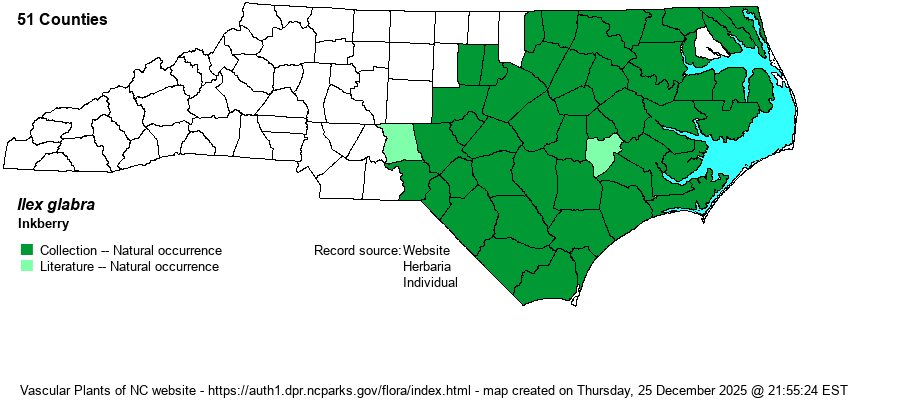| Author | (L.) A. Gray | |
| Distribution | Throughout the Coastal Plain, and along the eastern edge of the Piedmont west to Orange, Chatham, and Montgomery counties. There are no known out-of-range records for the state. It has been recorded from almost every Coastal Plain county in the state.
Found throughout the Atlantic Coastal Plain north to Nova Scotia and coastal ME, south though all of FL and west only to LA. There are a few well inland records in GA and MS.
| |
| Abundance | Very common, to often abundant, over the entire Coastal Plain. Uncommon in the eastern Piedmont counties of Wake, Durham, Orange, and Chatham, but rare in Piedmont counties along the VA line. | |
| Habitat | This is a species of acidic wetlands, though it is not as tied to pocosins as is Ilex coriacea. It is widespread in pine flatwoods, savannas (at least fire-suppressed ones), streamhead ecotones, margins of larger pocosins and bays, and even into more mesic pine woods, especially near seeps or hardpans where there is some moisture just below the surface. In the Piedmont it can occur in bottomlands or damp to mesic pinewoods. |
| Phenology | Blooms in May and June; fruits from September to November. | |
| Identification | This is a rather small to medium evergreen shrub, normally reaching only about 4-6 feet tall. It has thick and leathery, dark green alternate leaves that are oblanceolate (wider above the middle) and contain a few paired teeth toward the tip; each tooth has a corresponding tooth on the opposite side of the leaf. The leaves are only about 1.5 inches long. In the fall, the shrub is literally covered in black “berries” that may remain into the winter. This is an easy shrub to identify, as you should run into it daily in the Coastal Plain, especially in areas dominated by Longleaf (Pinus palustris) or Pond (P. serotina) pines. The similar Ilex coriacea averages larger in size, has wider and more rounded leaves, and has teeth that are not opposite each other. | |
| Taxonomic Comments | None
| |
| Other Common Name(s) | Little Gallberry, Small Gallberry, Evergreen Winterberry, Bitter Gallberry. A common name of Appalachian Tea is so absurd – it doesn’t occur anywhere near the Appalachians – that it is laughable. | |
| State Rank | S5 | |
| Global Rank | G5 | |
| State Status | | |
| US Status | | |
| USACE-agcp | FACW link |
| USACE-emp | FAC link |

